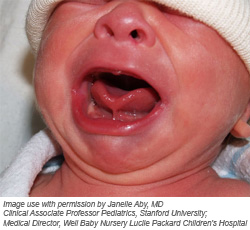Tongue-tie
What is a tongue-tie?
Tongue-tie (ankyloglossia) is a condition in which the bottom of the tongue is anchored to the floor of the mouth by a thin membrane (frenulum), which may restrict the mobility of the tongue. The condition varies from a mild form in which the tongue is bound only by a thin membrane, to a severe form in which the tongue is completely fused to the floor of the mouth. Tongue-tie occurs in approximately three per cent of the population.
How can tongue-tie affect breastfeeding?

Sometimes, a tongue-tie does not cause any problems and no treatment is required. However, a tongue-tie may prevent the baby from taking enough breast tissue into its mouth to form a teat, making it difficult for them to latch well to the breast and suck effectively. Consequently, the mother may experience painful, damaged nipples and low milk supply. Treatments for tongue-tie may improve baby's ability to breastfeed and help reduce nipple pain.
Tongue-tie has also been associated with future health concerns including: infants with speech and swallowing problems, oral development and dental problems.
What are the signs of a tongue-tie?

- Painful or damaged nipples while breastfeeding.
- Baby often loses suction while feeding and cannot stay latched to the breast.
- Baby becomes tired quickly when feeding.
- Baby has little or no weight gain.
- Baby is not able to touch the roof of their mouth with the tip of their tongue.
- Baby is not able to protrude their tongue past their lips.
- There is a thin membrane visible on the underside of the baby's tongue.
- The tip of baby's tongue may look heart-shaped or appear square instead of pointed.
Treatment
A thorough assessment by a lactation consultant and/or paediatrician will help you decide whether your baby requires any treatment. Treatment options include:
- Breastfeeding support and counselling from a lactation consultant.
- Tongue-tie release—frenotomy.
What is a frenotomy?
A frenotomy is a procedure commonly used to treat tongue-tie. This procedure is performed by a doctor, and involves using a pair of sterile scissors to snip the thin membrane under the tongue; releasing the tongue so that it can move more freely. There is usually very little bleeding and minimal complications with a frenotomy; the baby can breastfeed immediately after the procedure. Many mothers will notice an immediate difference in how well their baby feeds and a reduction in pain during the feed. Other babies may take one or two weeks to work out how to use their newly freed tongue and may continue to require support from a lactation consultant during this time.

References:
- Amir L, James J, Donath S. Reliability of the Hazelbaker Assessment Tool for lingual frenulum function. International Breastfeeding Journal 2006: 1(3)doi:10.1186/1746–4358–1–3
- Coryllos E, Genna C, Salloum A. Breastfeeding: best for baby and mother—congenital tongue-tie and its impact on breastfeeding. Newsletter of the American Academy of Pediatrics, Summer 2004, viewed 8 November 2011 http://www.aap.org/breastfeeding/files/pdf/BBM-8-27%20Newsletter.pdf - 2009-12-22
- Edmunds J, Miles S, Fulbrook P. Tongue-tie and breastfeeding: a review of the literature. Breastfeeding Review 2011; 19(1):19-26.
- Geddes D, Langton D, Gollow I, Jacobs L, Hartmann P, Simmer K. Frenulotomy for breastfeeding infants with ankyloglossia: Effect on milk removal and sucking mechanism as imaged by ultrasound.2007, viewed 31 July 2011, http://pediatrics.aappublications.org/content/122/1/e188.full.html
- National Institute for Clinical Excellence: Interventional procedures programme, Interventional procedures overview of division of ankyloglossia (tongue tie) in babies with difficulty breastfeeding. February 2005.
- Srinivasan A, Dobrich C, Mitnick H, Feldman P. Ankyloglossia in breastfeeding infants: the effect of frenotomy on maternal nipple pain and latch. Breastfeeding Medicine 2006: 1 (4): 216–24.
- The Royal Women's Hospital, Victoria. Tongue-tie information for families 2008, viewed 8 November 2011, www.thewomens.org.au/Tonguetieinformationforfamilies
Mater acknowledges consumer consultation in the development of this patient information.
Mater Doc Num: PI-CLN-430148
Last modified 21/8/2020.
Consumers were consulted in the development of this patient information.
Last consumer engagement date: 19/1/2014
For further translated health information, you can visit healthtranslations.vic.gov.au/ supported by the Victorian Department of Health and Human Services that offers a range of patient information in multiple languages.